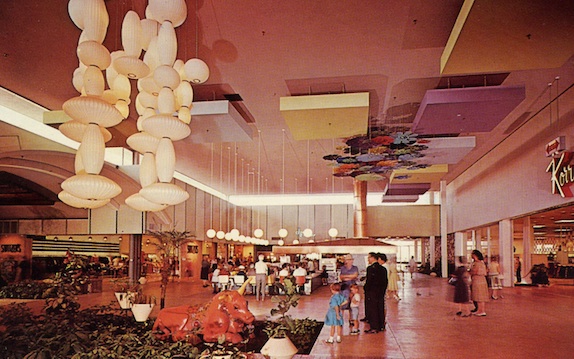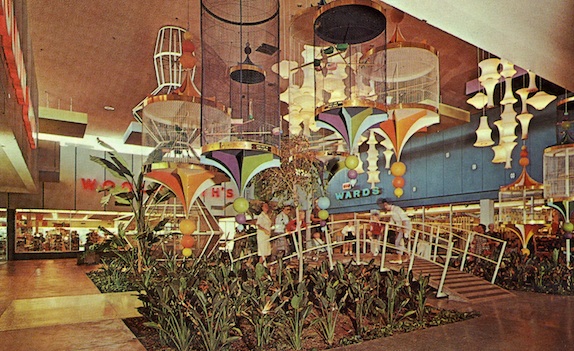
The Court of Flowers, postcard.
Because my grandfather owned a men?s clothing store and my dad briefly worked for him, I spent a lot of my childhood in malls. Hanging around malls is already a tradition in Phoenix, Arizona, where I grew up. It?s as central to life as driving and eating Mexican food, a habit stemming from a mix of materialism, a reflexive tendency to ?pass time,? and a very practical need for air conditioning. But it was also a habit born of an era when malls adorned themselves in gaudy architecture and country-and-western motifs, presented themselves as shopping experiences rather than just places to shop, and capitalized on Americans? aspirations toward glitz and glamour. I can?t enter one of the predictable, interchangeable modern retail spaces without thinking of the heyday of the mall, a period when, to borrow the title of a Time magazine article, malls were ?Pleasure-Domes with Parking.?
I saw none of these touches of class in person. I was born in 1975, and by then malls had changed. As I experienced it, my Grandpa Shapiro?s store, The Habber Dasher, was adjacent to the food court, an echoey hall enlivened by the greasy orange aroma of Pizza D?Amore and the sweet froth of Orange Julius, as well as Kay Bee Toys, the Red Baron video-game arcade, and the movie theater. My time at the mall was spent buying shockingly lifelike diecast metal cap guns at Kay Bee and then eating free samples of slow-cooked meat from the tiny gyro stall,? staring in horror at the hard, sunken eyes of the whole smoked fish in Miracle Mile Deli?s cold case, or looking up at the tall escalator that led into UA Cinema. When I walked through the open, indoor plaza where Santa Claus sat in a huge Styrofoam Wonderland, surrounded by polymer wads of fake snow while the sun shown outside, I had no clue that malls could be anything but what they were then, that they had any history at all.
In fact, shopping arcades and centers existed in the Western World as early as the 1920s. The classic, fully enclosed form now known in America as ?the mall? debuted in Edina, Minnesota, in 1956. An Austrian-American architect named Victor Gruen designed the so-called Southdale Center, and it became the de facto prototype for a wave of enclosed, temperature-controlled shopping complexes structured around big name ?anchors? and interior garden spaces.

Court of Birds, postcard.
As if the stores themselves weren?t attraction enough, many mid-century malls used flashy designs to lure shoppers. The first mall Gruen designed, named Northland Center, included avant garde giraffe sculptures, extensive landscaping, and spinning mobiles. Southdale Center went further. It had a twenty-one-foot birdcage containing fifty colorful birds, tropical plants, costumed Hawaiians serenading crowds, and a huge central square named the ?Garden Court of Perpetual Spring.?
Built in 1961, Chris-Town Mall, which housed my Grandpa Shapiro?s store, was one of the earliest to adopt Gruen?s design. In Gruen?s model, people would theoretically come to Chris-Town for the massive J. C. Penney, sit by the miniature planted palms and sip Joe inside Guggy?s Coffee Shop, and discover Godber?s Gifts, Chess King, and Tony?s Shoe Repair while strolling the intentionally large distance between Korrick?s Department Store and Montgomery Ward, the two anchors.
Chris-Town was Phoenix?s third mall, but it was Arizona?s first enclosed one, and it aimed to provide the glamorous Gruen experience. It was built around three themed courtyards: The Court of Flowers, Court of Fountains, and Court of Birds. The Court of Fountains was the central courtyard, with a low, circular fountain ringed by flowers and two stone staircases whose graceful arcs resembled those of high-heel shoes. Up until the early 1970s, an organ grinder walked the Court of Fountains with a monkey, collecting coins from shoppers.
The Court of Birds was an aviary in the west wing, complete with small bridges from which to view the sixty-four birds and their avant garde enclosures. One of the cages reached nearly to the ceiling, a cubist series of stacked trapezoids. At one point in time, the Court played host to a talking parrot named Chico, who was trained to greet shoppers by saying ?Welcome to Chris-Town.?
Finally, The Court of Flowers stood in the east wing and offered more subtle charms: an outdoor, U-shaped caf?, and a bunch of funky, bulbous lights overhanging a small garden plot and what appeared to be a red unicorn with a bright yellow horn, but which was actually, incongruously, a papier-m?ch? statue of Ferdinand the Bull.
Chris-Town was so popular that other Phoenix malls slapped lids on their open breezeways and pumped in air conditioning. They also aped its novelties. Thomas Mall featured a gimmick that made Chris-Town?s aviary look as dull as a parking lot: a monkey cage outside the J. G. McCrory?s five and dime.

Thomas Mall, postcard.
These are the days I long for when I think of the mall, an era when it was a place of leisure. But by the time I came of age, in the early eighties, everything had changed. Chris-Town was still noticeably Space Age in its architectural accents, but malls were a dime a dozen by then, and Chris-Town had outlived its elegant heyday by over a decade. The pink and powder blue of the early-sixties had given way to an eighties brown, yellow, and orange schema. Everything in the early Regan Era seemed to have the sickly tint of used cigarette butts: the marbled brown floor tiles, the faux wood pattern on the trashcans and ashtrays, the ubiquitous brass poles and fixtures.
For the institution of the mall, that was only the beginning of the end. By the 1990s, the market was saturated. Malls had multiplied so quickly that they cut into each other?s profits. The rise of the factory-outlet stores and large discount retailers such as Best Buy, Lowe?s, and Toys ?R? Us (often known as ?category killers?) lured customers away.
Some malls died a predictable death. Thomas Mall lost its anchors in the late eighties, was razed in 1993 and was replaced, in predictable fashion, by the modern version of the shopping mall: the ?power center.? Target, Sears, IHOP, Applebee?s?out with the old and in with the new. Unlike its predecessor, a power center is a pragmatic, often bare-bones affair. It?s open-air, and is built around a vast, communal parking lot. Its central visual features are cars and pavement, which gives it more in common with a freeway than the Place Dauphine. Counter to Gruen?s original European vision of a mall as the social center of a community, neither the power center nor its simpler forebear, the strip mall, are places to stroll or have relaxed conversation over cups of coffee.
Other dead malls have enjoyed a strange afterlife. The vacant husk of Maryvale Mall, in West Phoenix, was eventually converted into an unlikely amalgam that includes a middle and elementary school, community center, police substation, and a Wal-Mart. And some old malls have become purgatorial legends, like Dixie Square Mall, outside of Chicago, which opened in 1966, closed in 1978, and has stood dormant and decaying ever since. Its exposed corpse has attracted hordes of urban explorers and photographers.
Chris-Town?s demise was less dramatic. In a manner unbecoming a structure with three royal-sounding ?courts,? portions of Chris-Town were demolished, and the leftovers grafted with a Wal-Mart, Costco, and Target. I am not alone in mourning the demise of what it represented. Victor Gruen, the mastermind of the mall, eventually moved back to Vienna, where he criticized American urban planning and the bastardization of his ideas. Southdale was a failure, he said, as was every mall that copied it thereafter. He called these monstrosities shopping machines, said they damaged the natural landscape, destroyed city centers, dissolved social connections, drove small merchants out of business, and, aesthetically, were marred by ?the ugliness and discomfort of the land-wasting seas of parking? around them. It is an accurate description; we see these seas everywhere today.
Aaron Gilbreath has written essays?for Tin House, The Threepenny Review, Southern Humanities Review and Gastronomica. His Cincinnati Review essay about Googie architecture, ?Dreams of the Atomic Era,? is a Notable Essay in Best American Essays 2011.
Source: http://www.theparisreview.org/blog/2012/03/08/pleasure-domes-with-parking/
horsetail falls ice t downton abbey president day new york knicks lin j.r. smith
No comments:
Post a Comment
Note: Only a member of this blog may post a comment.